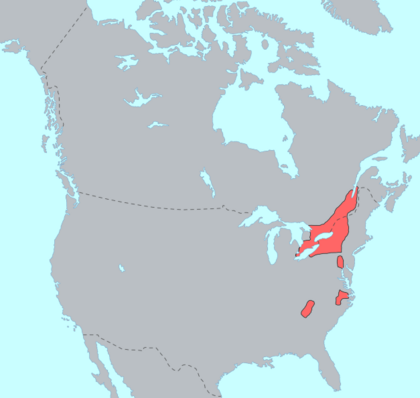Iroquoian peoples facts for kids
The Iroquoian peoples are a group of Native American peoples who lived in eastern North America. Their traditional lands, sometimes called Iroquoia, stretched from the St. Lawrence River in the north all the way to what is now North Carolina in the south.
Some of the well-known Iroquoian peoples include the Haudenosaunee (also known as the Iroquois), the Huron (or Wendat), the Petun, the Neutral people, and the Cherokee. These groups shared similar languages and ways of life.
Archaeologists have found signs that Iroquoian peoples lived in the area around present-day New York state as far back as 500 to 600 CE. Some evidence even suggests their presence much earlier, possibly around 4000 BCE. Their unique culture really started to take shape around 1000 CE.
Contents
Who are the Iroquoian Peoples?
Many different groups are part of the Iroquoian family. Here are some of them:
- Haudenosaunee (Iroquois): These people live in New York, Quebec, and Ontario.
- Huron (Wendat): From the Georgian Bay area in Ontario, Canada.
- Petun (Tobacco or Tionontati): Also from the Georgian Bay area in Ontario.
- Neutral Nation: Lived in southwestern Ontario.
- Erie: From Upstate New York, Ohio, and Northwest Pennsylvania.
- Conestoga (Susquehannock): Lived in Pennsylvania, West Virginia, New York, and Maryland.
- St. Lawrence Iroquoians: Found along the St. Lawrence River in Quebec and New York.
- Cherokee: A large group from North Carolina, Tennessee, South Carolina, Georgia, and Alabama.
A Look at Iroquoian History
Iroquoian stories tell us about their beginnings. One famous story says that their people came from a woman who fell from the sky. They believe they have always lived on Turtle Island, which is their name for North America.
When Europeans first arrived, they brought new diseases. These diseases spread quickly among the Iroquoian peoples. For example, by the mid-17th century, the Huron population dropped from about 20,000-30,000 people to only around 9,000. The Petun population also fell from about 8,000 to 3,000. This was a very difficult time for them.
Discoveries from Archaeology
Archaeology helps us learn about ancient Iroquoian peoples. The Hopewell tradition was a way of life shared by many Native American groups. They lived along rivers in the eastern and midwestern parts of North America. This was between 100 BCE and 500 CE. The Hopewell tradition wasn't one single group. Instead, it was many different groups connected by a large network of trade routes. This is known as the Hopewell exchange system.
Archaeologists have found proof of Iroquoian peoples in what is now New York state. This evidence dates back to around 500 to 600 CE. Some findings even suggest they were there as early as 4000 BCE. Their unique culture really started to develop around 1000 CE.
Ontario Iroquois Tradition
In Ontario, archaeologists study something called the Ontario Iroquois tradition. This refers to a group of ancient cultures that are thought to be Iroquoian or early Iroquoian. Around 900 AD, there were two main groups: the Glen Meyer and Pickering cultures. They lived in different parts of Ontario.
Later, around the 14th century, big changes happened. The differences between the Glen Meyer and Pickering cultures became less clear. Some archaeologists believe one group became more powerful. However, many experts now think these groups were more connected than first thought. They might have just been different parts of the same larger culture across southern Ontario.
Another important ancient culture was the Point Peninsula complex. This group lived in Ontario and New York from 600 BCE to 700 CE. This culture, along with others, likely helped shape the Iroquoian-speaking nations we know today.
Iroquoian Culture and Daily Life
Iroquoian peoples had a special way of organizing their families. They followed a matrilineal system. This means that family lines and property were passed down through the mother's side.
Historically, they were farmers who stayed in one place. They lived in large, strong villages. These villages were often surrounded by tall wooden fences called palisades. These fences could be thirty feet high! They helped protect the village from enemies. Besides farming, they also hunted and gathered food to add to their diet. A common type of home they lived in was the longhouse.


